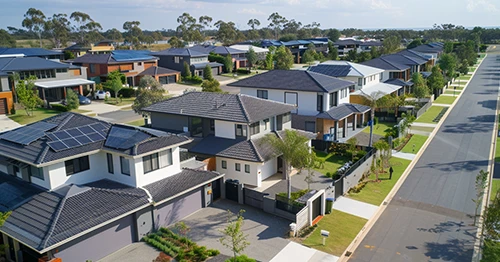Updated: 27 Dec, 2024
CoreLogic’s Home Value Index fell 1% in January 2023. This was the smallest month-on-month decline since June 2022. The reduction in the rate of decline was evident in most capital cities, except for Adelaide (-0.8%) and Perth (-0.3%), where housing values have been more steady than in other areas since interest rates started rising in May last year.
In January, the national Home Value Index was down 8.9% from its peak in April 2022, making this the largest and fastest decline in values since 1980, when CoreLogic’s records began. Sydney registered the largest decline from its 2022 peak among the capital cities, at -13.8%, while Brisbane and Hobart registered the second-largest declines, both at about 10.8%.
The most noticeable ease in falling values was in premium homes. Across the combined capitals, the rolling quarterly rate of decline in upper-quartile home values improved from -6.1% over the September 2022 quarter to -4% over the three months to January.
CoreLogic research director Tim Lawless said, “While this trend towards improving conditions across premium markets is not evident in all cities, it is most apparent in Sydney’s detached house market. Quarterly declines in this market segment eased from -7.7% in the three months to August to -3.9% in the three months to January. The improvement could be reflective of more buyers taking advantage of larger price drops across the premium sector, where house values are down 17.4% since peaking in January 2022.”
Property Market Highlights
Here’s a summary of the major data points from the Australian property market in January 2023:
- All capital cities experienced a decline in values, led by Hobart (-1.7%) and Brisbane (-1.4%). Perth and Darwin experienced the smallest declines, at -0.3% and -0.1%, respectively.
- Sydney’s values fell 1.2% and dropped below $1 million for the first time since March 2021.
- Regional housing values recorded a milder rate of decline than each of their capital counterparts. Across the combined non-capital city areas, housing values surged 41.6% higher through the upswing, compared with a 25.5% rise across the combined capital cities. Since the peak in June 2022, the combined regionals index is down 7.4%, while capital city values are now 9.6% below their April 2022 peak.
- The number of new capital listings added to the market over the four weeks ending 29 January was 22.2% lower over the same period last year and 24.5% below the five-year average. This could imply that homeowners do not want to sell and are prepared to wait out the downturn.
- Housing demand also fell. Over the past three months, capital city dwelling sales were estimated to be 24.9% lower, relative to the same period in 2022, and 11.5% below the previous five-year average.
- Relative to the same period last year, Sydney, Melbourne and Brisbane experienced the largest quarterly drops in sales, at 40.6%, 39.8% and 36.5%, respectively.
- Cities where home values held firmer recorded smaller falls in home sales. Adelaide experienced a drop of 2.8%, and Perth sales were just 3.6% lower.
- National rents were up 0.7% in January 2023 but still below the peak monthly rental growth rate of 1% in May 2022. The rise in the pace of rental growth was centred in the capital city markets, where monthly rental growth lifted from 0.6% in December 2022 to 0.8% in January 2023. Growth in rents across the combined rest-of-state areas fell from 0.6% in December 2022 to 0.4% in January 2023.
- A resurgence in overseas students could add to rental demand over the coming months. Inner-city rental precincts and suburbs close to universities could benefit. Sydney and Melbourne could experience a further tightening in vacancy rates and upwards pressure on rents. Inner Sydney rents were 20% higher over the past 12 months, and Inner Melbourne rents were 30% higher.
- Gross rental yields continued to trend higher, rising from a historic low of 3.21% in February 2022 to 3.85% in January 2023.
CoreLogic’s Property Market Outlook
- The trajectory of housing values remains intrinsically linked with the path of interest rates. The possibility of a cash rate rise could continue to erode borrowing capacity and exert additional downward pressure on housing values.
- Once interest rates move through a peak, housing values could stabilise. Lawless notes, ”The most obvious stimulus would come from a drop in interest rates, but any cut to the cash rate probably won’t occur until late this year at the earliest. Other factors that could support housing activity would be the rise in consumer sentiment, an easing in credit policy, such as reductions in APRA’s serviceability buffer, or fiscal incentives aimed at stimulating housing demand.”
- Around two-thirds of fixed-rate home loans expire in 2023. Many mortgage holders are moving from interest rates of around 2% to 6%. They are on the edge of a mortgage cliff.
- The low advertised supply has perhaps helped keep a limit on value declines, but a lift in supply without a commensurate rise in demand could prolong the downturn.
- With overseas migration accelerating, especially from international students, rental vacancies will likely remain tight, leading to further upward pressure on rents.






